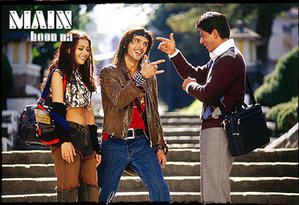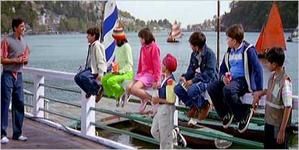Leave 'em kids alone: Main hoon na & Koi mil gaya
Publié le 23 Juin 2007

I regret to say - I do have a limit in what I like about Bollywood. It recently took the shape of two rather sickening shows, Main hoon na by Farah Khan, and Koi mil gaya, by Rakesh Roshan (of the Krrish fame). I’m half sorry and perplexed to have to write this, because I’ve read lots of reviews saying how these two films were super blockbusters; somebody even said Koi mil gaya was his (or her) “best hindi movie ever”… And Mani hoon na has been hailed as “an amazing film” by one viewer on IMDB (here) but thankfully for me, it was in a thread called “what a rubbish film”! Perhaps all this doesn’t mean much, but in fact, yes, it does. This blatant difference between my taste and other people’s made me wonder what my criteria are.
First, I think I can’t stand this pretence of adults acting as kids. Or to put it differently, I am uneasy with any director’s hope that comedy might come from putting a grownup at children’s level. The thought of seeing SRK or HR sitting there among wide-eyed children in a classroom is just too much. So what’s my problem? Comedy comes from oppositions, doesn’t it? If I think carefully, I think I know. The problem comes from the fact that this mixture of adulthood and childhood reveals a misunderstanding of what children are and do. The same thing happens in other films with children, such as Raju Chacha, where three kids are at the centre of a plot meant to rob them of their inheritance after their father has died. In this type of film, the director just hasn’t got round to understanding what childhood is. Compare this with Water, by Deepa Mehta.

And what is true for children is in a way also true for youngsters, or even college boys and girls. The codes along which they are characterised are in fact stereotypes[1], just like those used for children, and the imitation of these codes by adults, in the case of Main hoon na and Koi mil gaya, creates a sickening feeling of uneasiness. Obviously the difference between the two films is that Hrithik in Koi mil gaya is supposed to be a child, a mentally handicapped child. But my point is that NEVER do we believe that he is. He simply cannot play the 10 year-old child. I don’t necessarily hold it against him, because anyhow the story is so unlikely. I don’t say it has never happened, probably the contrary. But the way it’s done makes the situation so ridiculous: to avoid that, not only would Hrithik Roshan have needed to learn how to act like a child, but his classmates would have had to be taught to react towards him as if he was a child. But they give him off at every turn. That is perhaps the main reason why he isn’t believable. We continuously see Rohit through the eyes of his schoolmates: and this is perhaps natural, because they represent the audience which Rakesh Roshan has in mind: I suppose he wants them to enjoy the fun of superiority over adults, and this is one good opportunity. But something gets lost in the process: the mental handicap, with its alien misery. And of course the magic, and sometimes the violence of childhood. (Perhaps I’m too severe, because Rohit does get bullied in the film, but it’s by the bigger guys only. I think I know enough of playgrounds to say that this situation is unrealistic, and that 10 year olds can be just as cruel towards difference, especially mental difference)
Let’s now turn towards Main hoon na. The situation looks different, as Major Ram Prasad (SRK) doesn’t pretend to be of the same age as the college students he sits with for the purpose of the story. But the same phenomenon occurs nevertheless. There is this strange game the director is playing with educational conventions. Obviously the intention is to draw funny effects from this situation, but I’m afraid they are hard to pull off! Ram’s rigid self-respect was for me as painful to watch as Lucky’s swaggering pranks. And when Ram “falls” in love with Mrs Chandni, I didn’t know whether I was supposed to cry or cringe. Well, perhaps there was a certain amount of second degree there. I enjoyed the fights between Sunil and Shahrukh on the other hand, even if (or because?) they were so predictable.

It might not be very easy to film the younger classes of the population. Especially small children. Obviously you can rarely expect them to “act naturally”, as this is in itself a contradiction which the actor’s job is all about. But if it’s not done properly, then the scenes with children weigh a ton, and the movie’s interest drops immediately. A lot of care must be given to the relations between adults and children. In Kuch kuch hota hai, I found that this effort is rewarded, as the young children at the holiday camp are natural enough. I’ve already mentioned Water, a gem in this respect. I could also mention Khamoshi, the musical, where children are finely impersonated. But take Umrao Jaan: the two children, who play the heroine (when young) and her brother at the beginning, are painfully false. So it’s really a question of how much effort is put in this dimension of the characterisation, and also it’s probably a question of how much intuitive knowledge of childhood the director has. Childhood is our origin; our age of innocence (which doesn’t mean of angelhood, children aren’t angels). If a director misses that point, the risks that he doesn’t know some important dimensions of our human nature are quite great. And the situation is rather similar for youth: young people, especially teenagers, represent that part of our life when seriousness is present alongside a taste for risk and adventure, without which maturity and its authenticity cannot properly develop. Misinterpret that moment, that passage in life, and you get an anthropology which rings false. See Yuva: Mani Ratnam has managed to convey that sense of urgency and truth which characterises youth. Even at the cinema, we cannot play too much with those representations of childhood and of youth.
[1] Such stereotypes can be seen in Kuch kuch hota hai, or Mohabbatein.
/image%2F1489169%2F20200220%2Fob_9722d6_banner-11.JPG)